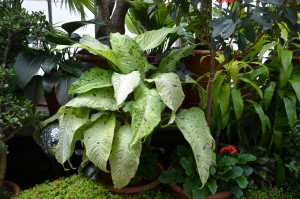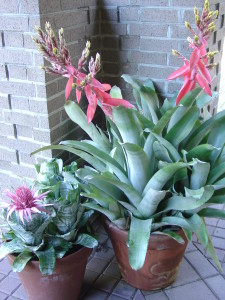Tropical house plants decorate homes, restaurants, shopping malls, and work environments (USDA hardiness zones 8 through 11). Many will grow in medium to low light areas of your home, work, and where flowering plants do not perform. Here are some basic house plant tips:
They languish in areas where temperatures are below 55 °F. Dry room air often results in brown leaf edges. Room humidity can be raised by setting a plant on a tray of wet gravel (but not sitting in standing water), or close by a room humidifier. Simply grouping several plants close together will raise the humidity.
Spring, summer, and fall feed plants every 2 – 3 weeks with a water soluble “house plant fertilizer” at one-half package directions. Winter feeding is usually unnecessary or performed once monthly. Once monthly, flush the soil with water to leach out excess fertilizer salts.
Plants may be moved outdoors in summer and placed under a large shade tree in filtered or indirect light and temperatures between 55 – 90 °F.
Occasionally rinse large leafy foliage plants with a garden hose or bath shower to remove dust and pollen. Turn large foliage plants regularly to supply adequate light to all sides of plant(s) and prevent it from reaching outward toward light source.
Over time bottom leaves will brown and die out. This is natural. Snip them off to keep the plant tidy.
Water thoroughly and as needed. Never overwater your houseplants. Irrigate with non-fluoridated, room temperature water to avoid burning the foliage.
Repot annually. Choose a container 2 inches larger than the existing one. Shake old soil away from roots and replace with a well-drained potting mix.
Disease and insect problems are rare, but occasionally happen. Inspect plants every few weeks for scale, mealy bugs, mites and aphids. Their feeding symptoms cause leaf curl, speckling, or bronzing of the foliage. In particular, inspect underside of leaves for webbing. Spray with insecticidal soap or neem oil every one to two weeks until pest has been managed.
Caution: The leaves of some house plants are toxic and should not be ingested. While most are not poisonous and cause death, some may cause temporary swelling of the tongue and throat, leading to a temporary loss of speech or stomach aches. Some common examples are dumbcane (Dieffenbachia), Chinese Evergreen (Aglaonema). Sap from Crown of Thorns (Euphorbia) may result in skin irritation. Keep such plants away from children or pets that might be tempted to taste it.



 Posted in
Posted in 
